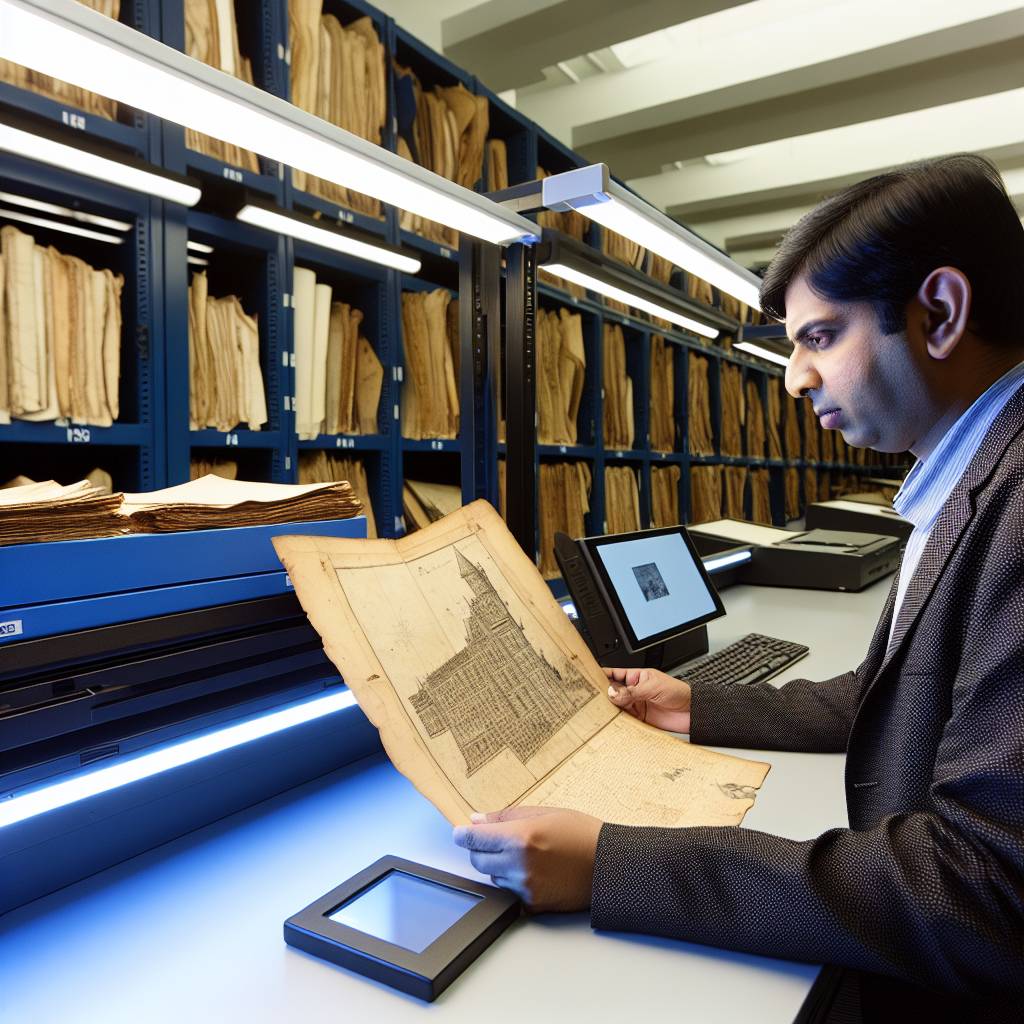Overview of Modern Archival Practices
The Role of Technology in Archiving
Modern archivists embrace technology to enhance their work.
They utilize diverse tools and software for efficient processes.
For example, digital asset management systems streamline organization.
Additionally, cloud storage offers secure, flexible access to collections.
Digital Preservation Techniques
Digitization plays a key role in preserving archival materials.
The process involves creating digital copies of physical items.
Modern archivists often use scanners and image editing software.
These tools ensure high-quality representations of original documents.
Data Management and Inventory Control
Effective data management is essential for modern archivists.
Archivists often implement databases to track collections systematically.
Inventory control helps maintain accurate records and metadata.
Moreover, professionals use software like ArchivesSpace for organization.
Collaboration and Knowledge Sharing
Collaboration among archivists enhances knowledge sharing.
They participate in professional networks and forums for support.
Additionally, online platforms facilitate the sharing of best practices.
This engagement fosters innovation in archival methodologies.
Challenges in Modern Archiving
Despite advancements, archivists face ongoing challenges.
Data security remains a critical concern in digital archiving.
Furthermore, preserving born-digital materials requires specialized strategies.
Archivists continuously adapt to address these evolving needs.
Key Digital Tools for Archivists
Digital Asset Management Systems
Archivists use digital asset management (DAM) systems to organize and store digital files.
These tools facilitate efficient retrieval of materials when needed.
Popular DAM systems include AtoM and Omeka.
Metadata Standards and Schema
Metadata standards like Dublin Core and EAD help archivists describe collections effectively.
Using these standards ensures consistency across digital archives.
Unlock Your Career Potential
Visualize a clear path to success with our tailored Career Consulting service. Personalized insights in just 1-3 days.
Get StartedFurthermore, they enhance discoverability for researchers and the public.
Cloud Storage Solutions
Cloud storage solutions provide a secure way to backup and share archival materials.
Platforms such as Google Drive and Dropbox enable seamless collaboration among archivists.
They also allow easy access from different locations.
Digitization Equipment
For physical records, digitization equipment is essential.
High-quality scanners convert documents into digital formats.
Moreover, software like Adobe Acrobat aids in editing digital files.
Preservation Software
Preservation software helps archivists maintain digital integrity over time.
Tools like Archivematica automate the digital preservation process.
They ensure that digital records remain accessible and usable.
Data Visualization Tools
Data visualization tools assist in presenting archival information clearly.
Tools like Tableau and Google Charts allow archivists to create engaging visual formats.
These visualizations help communicate complex data and trends effectively.
Social Media and Engagement Platforms
Social media engages the public and promotes archival collections.
Platforms like Twitter and Instagram allow archivists to share highlights and updates.
This outreach helps foster connections with the community.
Importance of Digital Preservation Technologies
Preserving Cultural Heritage
Digital preservation technologies protect valuable cultural heritage.
They ensure that historical records remain accessible for future generations.
Without these technologies, many records would deteriorate and vanish.
Facilitating Research and Education
These technologies enhance research opportunities for historians and scholars.
Digital archives allow easy access to documents across the globe.
Moreover, they support educational initiatives by providing extensive resources.
Ensuring Data Integrity
Digital preservation technologies maintain the integrity of archival materials.
Regular checks and updates help protect against data corruption.
They utilize various methods to guarantee long-term data reliability.
Enhancing Accessibility
These technologies improve the accessibility of archival content.
They provide various formats that cater to diverse user needs.
As a result, more individuals can engage with historical documents.
Supporting Collaboration
Digital preservation fosters collaboration among archivists and organizations.
Shared resources streamline workflows and enhance preservation efforts.
Furthermore, collaboration leads to the development of best practices.
Learn More: How to Price Your Work as a Graphic Designer
Software Solutions for Cataloging and Metadata Management
Importance of Software in Archival Practices
Software plays an essential role in modern archival practices.
It simplifies the cataloging process and enhances metadata management.
Moreover, robust software solutions increase the efficiency of archivists.
They allow for better organization and retrieval of archival materials.
Popular Cataloging Software
Several cataloging software solutions are popular among archivists.
For instance, Archiware P5 is well-regarded for its user-friendly interface.
Similarly, ArchivesSpace offers a comprehensive platform for managing archival collections.
Another option is AtoM, which stands for Access to Memory, focusing on accessibility.
These tools enable archivists to create metadata standards easily.
Metadata Management Tools
In addition to cataloging software, various tools assist with metadata management.
MarcEdit is one such tool that aids in creating and editing MARC records.
Meanwhile, Omeka offers a user-friendly interface for digital collections.
Additionally, DSpace serves universities and research institutions well.
These tools help ensure consistency and efficiency in metadata creation.
Data Backup and Preservation Technologies
Effective backup solutions are vital for long-term data preservation.
Tools like Preservica provide secure storage for digital archives.
Another good example is BitCurator, which focuses on digital forensics.
Both options offer comprehensive preservation strategies for valuable data.
Collaboration and Sharing Platforms
Collaborative tools enhance communication among archivists.
Platforms like Google Workspace enable real-time collaboration on documents.
Additionally, Slack fosters channels for discussion and quick updates.
These technologies effectively improve teamwork and project coordination.
Cloud Solutions in Archival Management
Cloud computing has transformed how archives manage data.
Solutions like Amazon Web Services offer scalable storage options.
Similarly, Microsoft Azure provides flexibility and security for sensitive data.
These cloud solutions ensure easy access to archival materials from anywhere.
Ultimately, they enable efficient management of resources and data integrity.
Learn More: Graphic Design Career Paths You Need to Explore
Role of Cloud Storage in Archival Strategies
Importance of Cloud Storage
Cloud storage transforms how archivists manage large datasets.
This technology offers scalability and flexibility.
Archivists can store vast amounts of data without significant physical limitations.
Additionally, cloud storage enhances accessibility of archival materials.
Collaboration and Sharing
Cloud platforms enable easy collaboration among archivists.
Teams can access and work on documents in real-time.
This boosts productivity and fosters teamwork.
Moreover, cloud storage simplifies sharing resources with external partners.
Data Security and Backup
Data security is a primary concern for archivists.
Cloud storage providers offer robust security measures.
These include encryption and multi-factor authentication.
Furthermore, cloud systems ensure automatic backups.
This reduces the risk of data loss due to hardware failure.
Cost-Effectiveness
Using cloud storage can be more cost-effective than traditional options.
Organizations can avoid expensive hardware investments.
Additionally, they pay only for the storage they use.
This ensures better budget management for archival projects.
Environmental Considerations
Choosing cloud storage can also be environmentally beneficial.
It reduces the need for physical storage space.
This minimizes carbon footprints associated with maintaining large facilities.
By opting for cloud solutions, archivists contribute to sustainability efforts.
Explore Further: Common Challenges for Graphic Designers and Solutions

Emerging Technologies: AI and Machine Learning in Archiving
Introduction to AI and Machine Learning
Artificial intelligence (AI) and machine learning (ML) play vital roles in modern archiving.
These technologies help archivists process vast amounts of data efficiently.
Moreover, they enhance the preservation and accessibility of records.
Enhancing Data Processing
AI algorithms automate routine tasks in the archiving process.
For instance, they can classify and categorize documents quickly.
This automation saves significant time for archivists.
Natural Language Processing
Natural language processing (NLP) allows systems to understand human language.
This capability aids in indexing and searching archived records.
Consequently, users can retrieve information with ease.
Improving Access and Retrieval
Machine learning enhances search functions within archival databases.
Through predictive analytics, systems suggest related documents effectively.
Users experience faster and more intuitive searches.
Sentiment Analysis for Records
Sentiment analysis can assess the emotional tone of texts.
This analysis helps archivists identify key themes in archived materials.
Thus, it strengthens the understanding of historical context.
Data Preservation Techniques
AI technology supports data preservation through anomaly detection.
It identifies potential threats to the integrity of archival materials.
Furthermore, it aids in creating more effective backup strategies.
Automatic Format Conversion
Machine learning algorithms facilitate automatic format conversion.
This process ensures that records remain accessible across various platforms.
As a result, archival materials maintain their relevance over time.
Challenges and Considerations
Implementing AI and ML technologies is not without challenges.
Archivists must address issues related to data privacy and security.
Additionally, they should ensure that technologies are impartial and transparent.
Continuous Learning and Adaptation
Machine learning systems require constant updates to improve accuracy.
Archivists must stay informed about advancements in technology.
Continuous learning enables better adaptation of new tools in archiving practices.
Explore Further: How to Stay Inspired as a Canadian Content Creator
Collaborative Tools for Archival Projects
Importance of Collaboration
Collaboration enhances the efficiency of archival projects.
It allows archivists to share knowledge and resources.
Additionally, effective teamwork can lead to innovative solutions.
Cloud-Based Storage Solutions
Cloud storage provides a secure way to store archival materials.
Platforms like Google Drive and Dropbox facilitate easy access.
These tools enable multiple users to work on files simultaneously.
Project Management Software
Project management tools help archivists stay organized.
Software such as Trello and Asana simplifies task assignment.
These platforms allow for tracking progress and deadlines effortlessly.
Digital Communication Tools
Effective communication is vital for collaborative projects.
Tools like Slack and Microsoft Teams enhance real-time interaction.
These platforms foster discussions and share updates seamlessly.
Collaborative Documentation Tools
Documentation is essential for preserving project details.
Google Docs enables teams to create and edit documents together.
Furthermore, this tool keeps a history of changes for reference.
Specialized Archival Software
Archival software supports specific needs for managing collections.
Tools like ArchivesSpace and AtoM provide structured solutions.
These applications help in creating, managing, and sharing archival metadata.
Training and Support Resources
Training is essential for effective use of collaboration tools.
Organizations like the Society of American Archivists offer workshops.
Moreover, online tutorials can provide additional guidance and support.
Best Practices for Using Social Media in Archival Outreach
Choosing the Right Platforms
Select social media platforms that align with your audience’s interests.
Facebook and Twitter are great for general outreach.
Instagram excels in visual storytelling and engagement.
LinkedIn is ideal for professional networking and collaborations.
Regularly assess where your audience engages most.
Creating Engaging Content
Share high-quality images of archival materials to attract attention.
Utilize videos to provide deeper insights into your collections.
Consider sharing behind-the-scenes content to humanize your work.
Use infographics to present data in a visually appealing way.
Craft stories around your archival items to foster connections.
Establishing a Consistent Posting Schedule
Create a content calendar to plan your posts.
Be consistent with your posting frequency to keep your audience engaged.
Analyze engagement metrics to determine optimal posting times.
Mix content types to maintain audience interest.
Adjust your schedule based on audience feedback and engagement analytics.
Engaging with Your Audience
Respond promptly to comments and messages to foster community.
Ask open-ended questions to encourage discussions.
Host live Q&A sessions to directly engage with followers.
Highlight user-generated content to build a sense of belonging.
Show appreciation for your audience’s support and feedback.
Leveraging Hashtags and Trends
Use relevant hashtags to increase visibility and reach.
Participate in trending conversations to stay relevant.
Create a unique hashtag for your archival projects to track engagement.
Engage with other institutions to broaden your outreach.
Monitor hashtag performance to refine your strategy.
Tracking and Analyzing Performance
Use analytic tools to measure your social media impact.
Track engagement metrics such as likes, shares, and comments.
Assess follower growth over time for insight into your outreach success.
Adjust your strategy based on data insights and audience behavior.
Regularly review goals to ensure continued effectiveness.




